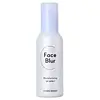Naked Sundays Collagen Glow 100% Mineral Sunscreen SPF 50+ Versus Etude House Face Blur Moisturizing SPF 28 PA+
What's inside
What's inside
 Key Ingredients
Key Ingredients

 Benefits
Benefits

 Concerns
Concerns

 Ingredients Side-by-side
Ingredients Side-by-side

Zinc Oxide
Cosmetic ColorantWater
Skin ConditioningCoco-Caprylate/Caprate
EmollientPhenoxyethanol
PreservativeEthylhexylglycerin
Skin ConditioningCollagen
MoisturisingSodium Benzoate
MaskingSodium Chloride
MaskingPEG-8 Stearate
EmulsifyingOctyldodecanol
EmollientCitrullus Lanatus Fruit Extract
Skin ConditioningCaprylic/Capric Triglyceride
MaskingGlycerin
HumectantPolyglyceryl-3 Polyricinoleate
EmulsifyingCetearyl Alcohol
EmollientDisodium EDTA
Xanthan Gum
EmulsifyingGluconolactone
Skin ConditioningIsostearic Acid
CleansingCetearyl Glucoside
EmulsifyingHydrolyzed Soy Protein
HumectantRice Amino Acids
Skin ConditioningCalcium Gluconate
HumectantProline
Skin ConditioningHydrolyzed Adansonia Digitata Seed Extract
Iron Oxides
Zinc Oxide, Water, Coco-Caprylate/Caprate, Phenoxyethanol, Ethylhexylglycerin, Collagen, Sodium Benzoate, Sodium Chloride, PEG-8 Stearate, Octyldodecanol, Citrullus Lanatus Fruit Extract, Caprylic/Capric Triglyceride, Glycerin, Polyglyceryl-3 Polyricinoleate, Cetearyl Alcohol, Disodium EDTA, Xanthan Gum, Gluconolactone, Isostearic Acid, Cetearyl Glucoside, Hydrolyzed Soy Protein, Rice Amino Acids, Calcium Gluconate, Proline, Hydrolyzed Adansonia Digitata Seed Extract, Iron Oxides
Water
Skin ConditioningGlycerin
HumectantButylene Glycol
HumectantDipropylene Glycol
HumectantEthylhexyl Methoxycinnamate
UV AbsorberTitanium Dioxide
Cosmetic ColorantEthylhexyl Salicylate
UV AbsorberOctyldodecanol
EmollientNiacinamide
SmoothingHydrogenated Polydecene
EmollientDiethylamino Hydroxybenzoyl Hexyl Benzoate
UV Filter1,2-Hexanediol
Skin ConditioningPolysorbate 60
EmulsifyingIsododecane
EmollientNeopentyl Glycol Diheptanoate
EmollientSodium Hyaluronate
HumectantMica
Cosmetic ColorantTrimethylsiloxysilicate
EmollientGlyceryl Stearate
EmollientPEG-100 Stearate
Methyl Methacrylate Crosspolymer
Cetearyl Alcohol
EmollientCI 77007
Cosmetic ColorantDimethicone
EmollientPolypropylsilsesquioxane
Hydroxyethyl Acrylate/Sodium Acryloyldimethyl Taurate Copolymer
Emulsion StabilisingAmmonium Acryloyldimethyltaurate/Vp Copolymer
Tocopheryl Acetate
AntioxidantGlyceryl Acrylate/Acrylic Acid Copolymer
HumectantCaprylyl Glycol
EmollientDimethicone/Vinyl Dimethicone Crosspolymer
Skin ConditioningSqualane
EmollientAdenosine
Skin ConditioningHydrogenated Lecithin
EmulsifyingDisodium EDTA
Ethylhexylglycerin
Skin ConditioningParfum
MaskingWater, Glycerin, Butylene Glycol, Dipropylene Glycol, Ethylhexyl Methoxycinnamate, Titanium Dioxide, Ethylhexyl Salicylate, Octyldodecanol, Niacinamide, Hydrogenated Polydecene, Diethylamino Hydroxybenzoyl Hexyl Benzoate, 1,2-Hexanediol, Polysorbate 60, Isododecane, Neopentyl Glycol Diheptanoate, Sodium Hyaluronate, Mica, Trimethylsiloxysilicate, Glyceryl Stearate, PEG-100 Stearate, Methyl Methacrylate Crosspolymer, Cetearyl Alcohol, CI 77007, Dimethicone, Polypropylsilsesquioxane, Hydroxyethyl Acrylate/Sodium Acryloyldimethyl Taurate Copolymer, Ammonium Acryloyldimethyltaurate/Vp Copolymer, Tocopheryl Acetate, Glyceryl Acrylate/Acrylic Acid Copolymer, Caprylyl Glycol, Dimethicone/Vinyl Dimethicone Crosspolymer, Squalane, Adenosine, Hydrogenated Lecithin, Disodium EDTA, Ethylhexylglycerin, Parfum
Ingredients Explained
These ingredients are found in both products.
Ingredients higher up in an ingredient list are typically present in a larger amount.
Cetearyl alcohol is a mixture of two fatty alcohols: cetyl alcohol and stearyl alcohol. It is mainly used as an emulsifier. Emulsifiers help prevent the separation of oils and products. Due to its composition, it can also be used to thicken a product or help create foam.
Cetearyl alcohol is an emollient. Emollients help soothe and hydrate the skin by trapping moisture.
Studies show Cetearyl alcohol is non-toxic and non-irritating. The FDA allows products labeled "alcohol-free" to have fatty alcohols.
This ingredient is usually derived from plant oils such as palm, vegetable, or coconut oils. There is debate on whether this ingredient will cause acne.
Due to the fatty acid base, this ingredient may not be Malassezia folliculitis safe.
Learn more about Cetearyl AlcoholDisodium EDTA plays a role in making products more stable by aiding other preservatives.
It is a chelating agent, meaning it neutralizes metal ions that may be found in a product.
Disodium EDTA is a salt of edetic acid and is found to be safe in cosmetic ingredients.
Learn more about Disodium EDTAEthylhexylglycerin (we can't pronounce this either) is commonly used as a preservative and skin softener. It is derived from glyceryl.
You might see Ethylhexylglycerin often paired with other preservatives such as phenoxyethanol. Ethylhexylglycerin has been found to increase the effectiveness of these other preservatives.
Glycerin is already naturally found in your skin. It helps moisturize and protect your skin.
A study from 2016 found glycerin to be more effective as a humectant than AHAs and hyaluronic acid.
As a humectant, it helps the skin stay hydrated by pulling moisture to your skin. The low molecular weight of glycerin allows it to pull moisture into the deeper layers of your skin.
Hydrated skin improves your skin barrier; Your skin barrier helps protect against irritants and bacteria.
Glycerin has also been found to have antimicrobial and antiviral properties. Due to these properties, glycerin is often used in wound and burn treatments.
In cosmetics, glycerin is usually derived from plants such as soybean or palm. However, it can also be sourced from animals, such as tallow or animal fat.
This ingredient is organic, colorless, odorless, and non-toxic.
Glycerin is the name for this ingredient in American English. British English uses Glycerol/Glycerine.
Learn more about GlycerinOctyldodecanol is a fatty alcohol. It is primarily used to enhance the texture of products.
As an emulsifier, Octyldodecanol helps prevent the oils and waters from separating. It also prevents ingredients from creating foam when shaken.
Octyldodecanol is created by reducing fatty acid to an alcohol.
Due to its high molecular weight, it does not get absorbed into the skin.
Learn more about OctyldodecanolWater. It's the most common cosmetic ingredient of all. You'll usually see it at the top of ingredient lists, meaning that it makes up the largest part of the product.
So why is it so popular? Water most often acts as a solvent - this means that it helps dissolve other ingredients into the formulation.
You'll also recognize water as that liquid we all need to stay alive. If you see this, drink a glass of water. Stay hydrated!
Learn more about Water